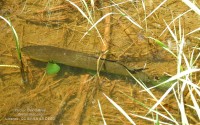Areolate grouper
(Epinephelus areolatus)

Image source: Jo's Animal Database
Classification
General data
The areolate grouper is a medium size fish (up to 47 cm long, 1.4 kg) that lives near coral reefs. Its coloration is whitish to gray with rounded brownish spots; it is particularly identifiable by a narrow, white, straight margin on its truncate tail. It has 11 dorsal spines, 15-17 dorsal soft rays, 3 anal spines and 8 anal soft rays.
It is often confused with the brownspotted grouper (Epinephelus chlorostigma) found in the Persian Gulf and several other many-spotted species.
The areolate grouper is found in the tropical region ranging from 35°N - 33°S, 29°E - 180°E. They are found in the Indo-Pacific region from the Red Sea and the Persian Gulf to Natal, South Africa and east to Fiji, north to Japan, south to the Arafura Sea and northern Australia. It was recently recorded to have been observed in Tonga, but appears to be absent from areas in the western Indian Ocean.
Recently (2015) a single specimen was reported from the Mediterranean Sea, off Israel.
This grouper is usually found in seagrass beds or on fine sediment bottoms near rocky reefs, dead coral, or alcyonarian corals. in shallow continental shelf waters. Juveniles are common at water depths to 80 m (260 ft); eggs and early larvae are probably pelagic.








